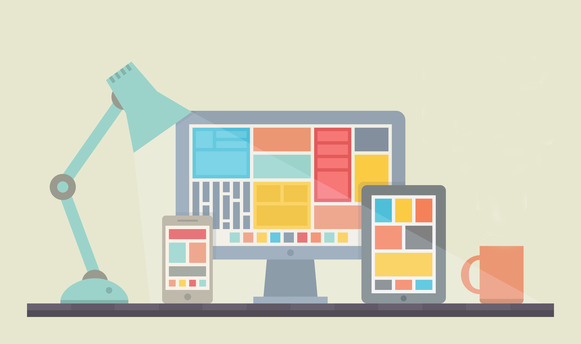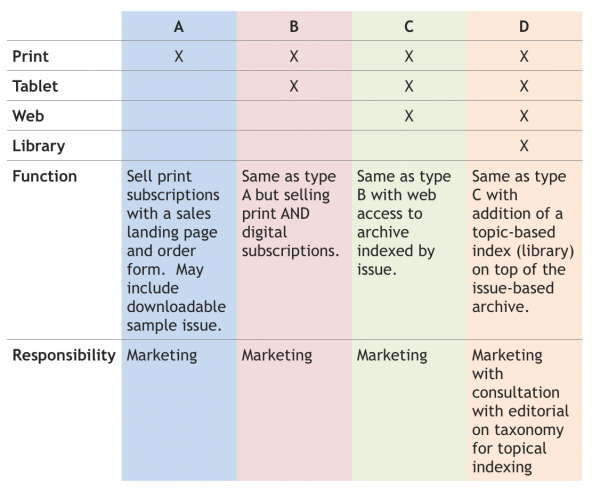The best website architecture includes old and new content

Ten years ago, most magazine publishers fell into two camps when it came to online magazine publishing. Some buried their heads in the sand and did little or nothing, apparently hoping this crazy fad would pass. We’ll call them “Reluctants.” Others jumped in, investing enormous amounts of time and money with little or no planning and mixed results at best. We’ll call this group the “Eager Beavers.” Of course there were publishers who did have a plan, executed it well, and achieved success, but they were more the exception.
Today, the Reluctants have accepted that they need to get on board with the web, and have even come to accept that a digital magazine is probably in their future. They just don’t know how to get started.
Meanwhile, the Eager Beavers continue to believe that online magazine publishing is important, but may feel they were burned by the hype over something that hasn’t really panned out.
So we thought it might be a good time to discuss the basic magazine website approaches, or archetypes, that we see, to provide both groups with an understanding of how to successfully build the foundation of a profitable digital magazine publishing business.
First, let’s define what we mean by a magazine website, or what we technically refer to as a magazine subscription website. As defined in our post on the magazine subscription website business model.
“A magazine subscription website archetype is set up to build subscriptions for a related print or digital magazine and to provide access to issues of the magazine.
A magazine website is only a magazine website if the user can view or download an issue of a magazine—one that is linear and periodic, has pages and a regular frequency, and can be viewed in HTML, downloaded as a PDF or downloaded to a mobile device.”
[Note: Magazine subscription websites are one of nine subscription website models, or archetypes, which we write about frequently.]
There are four basic magazine subscription website archetypes (pronounced ‘ark-uh-types’) as shown in the table below.
[text_ad]
The Four Magazine Subscription Website Archetypes

Magazine subscription website archetype: type A
There is no content on this type of a magazine subscription website. It is purely designed to sell subscriptions. Some publishers, believing that they must have content on their website, post some articles to their type A site, but this only clouds the waters, distracting visitors from the goal – getting them to subscribe to the magazine.
The type A magazine subscription website is essentially a direct mail package, encouraging visitors to subscribe to the print edition of a magazine.
Magazine subscription website archetype: type B
Like type A, the type B magazine subscription website includes no content. It is almost identical but sells a choice of subscriptions – print or digital. If you sell subscriptions to your digital magazine on this website, to be distributed by Apple, Amazon, or other third parties, you need an entitlement server, so subscribers can sign into their account.
This may be handled on your website or by connecting to a third party, such as a fulfillment vendor. This adds some complexity but is unavoidable if you want to be able to sell digital magazine subscriptions directly and maintain a direct relationship with your subscribers.
Magazine subscription website archetype: type C
The type C magazine subscription website sells print and digital subscriptions like type B, but it adds another component – content. The website includes archived content, organized by issue. That’s a big step. It means uploading and organizing your current and past content in a content management system.
Most often, this web archive access is included with a print or digital subscription for one universal access price, permitting subscribers to find and read articles from previously published issues right on the website. Therefore, like type B, this type of magazine subscription website requires an entitlement server.
Magazine subscription website archetype: type D
The type D magazine subscription offers everything found in type C with the addition of an archive of back content organized by topic (what we refer to as a library). All together this forms a magazine reference website.
The hard work of uploading and organizing the content has already been done for type C, so the incremental effort required is modest – you just need to add the ability to search based on topic.
The payoff for that effort is substantial, however, as you are significantly increasing the usefulness to your subscribers. In addition to selling subscriptions, this type of website provides the convenience of quick access to back issues plus the ability to research everything you’ve had to say on a given topic.
This adds a “lean forward” capability to your subscribers’ “lean back” experience, which enhances the value and therefore the price they’re willing to pay, enabling you to use decoy pricing to increase the average order size.
What type of magazine subscription website should you have?
At the risk of stating the obvious, Mequoda recommends moving towards type D.
For you as the publisher, type D is the most effective for attracting new subscribers and extracting maximum value. And for your subscribers, type D provides the ability to have a smooth, digital user experience, enabling them to receive issues, find back issues, and efficiently research to find answers to specific questions. And with responsive design, tablet-friendly digital magazines are seeing growing acceptance by readers.
Broken down like this, the distinction between the four types might seem somewhat trivial, but you need to understand what sort of magazine website you want. One important implication is that the type of magazine subscription website you build clarifies which resources you should devote to it.
We have seen publishers who are not clear on what type of magazine subscription website they have. They spend a great deal of time and money on type A magazine websites, which is overkill. Types A and B are marketing websites. Types C and D are still marketing websites that also add an editorial component.
If you have a type A or B magazine subscription website, there’s no reason to push your content except to the extent that your testing indicates that the inclusion of sample content helps you sell subscriptions. (By the way, our experience is that in most cases, good sales copy works best and a lot of sample content only serves to distract visitors from your goal of getting them to subscribe.)
I’ve had experience with publishers who have been unclear on what they’re trying to do with their magazine subscription website. It makes for a muddled user experience and can create a lot of extra work and aggravation, as the lines of responsibility for marketing and editorial are not clear.
What’s your experience? What type of magazine subscription website do you have? Does everyone in your organization agree, and understand the implications? Share your comments below.



Thank you Bernie. That is certainly an option. As I noted, this post was discussing “the basic magazine website approaches, or archetypes, that we see” and we just aren’t seeing that very much yet. We have more than one client right now that we are talking with about Model E however so there will undoubtedly be more of Model E showing up in the future.
What about Model E? No print … just Tablet, Web, Library.